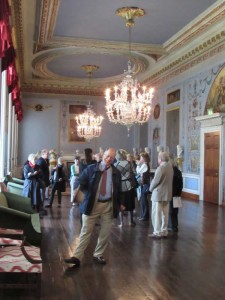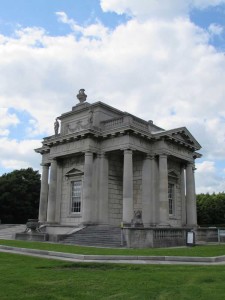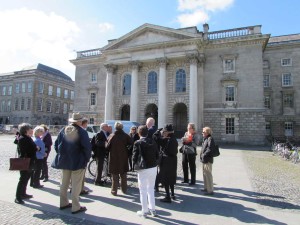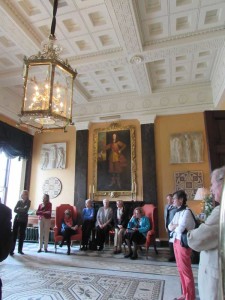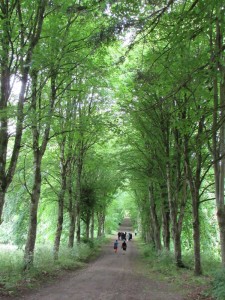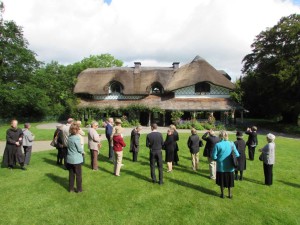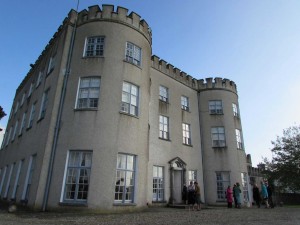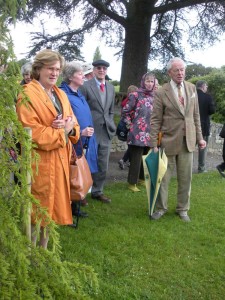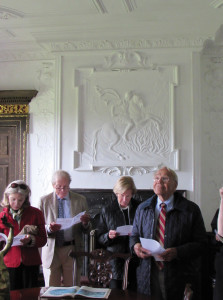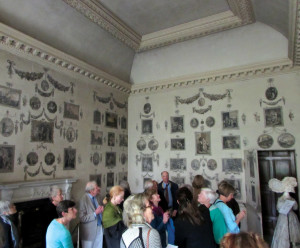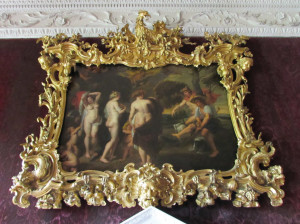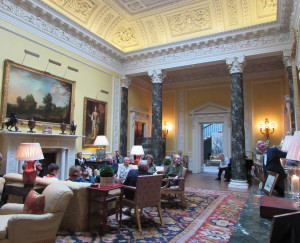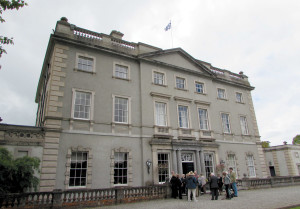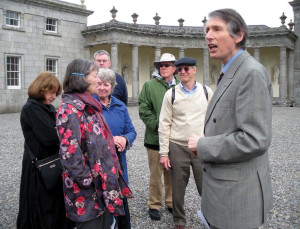Irish Eyes Smile upon the Trust
EVENTS > STUDY TRIPS ABROAD
In Review: Spring Study Trip Abroad 2014
The unprecedented demand for the Trust’s spring Study Trip Abroad to Ireland was duly warranted, for the 48 participants in the two outings were treated to a spectacular tour of the stately houses, gardens, and collections found in the Celtic countryside. Led by Nicola Howard, making her Trust debut on behalf of Specialtours, the itinerary offered a tremendous introduction to the grandeur of Ireland’s architectural and artistic heritage.
Celebrity Architects
The prosperity of Anglo-Irish landholders throughout much of the 18th century fueled a building boom that emanated from Dublin throughout the 32 counties. Ireland’s most talented native-born architect of the 18th century, Sir Edward Lovett Pearce, tragically died early in his career after meeting great success with the Irish Houses of Parliament and the wings and interior of Castletown. The country did not see another domestic talent in the trade until the rise of Richard Morrison and his son, William Vetruvius Morrison, who popularized the Regency taste found at Fota and Ballyfin.
Celebrity architects in Britain, including William Chambers, James Gibbs, Robert Adam, John Nash, and James Wyatt, were commissioned to design urban town houses, country villas, and pleasure houses for members of the burgeoning Irish gentry. However, German immigrant Richard Castle (née Cassels) was largely responsible for spreading the taste for Palladianism introduced by Pearce through his work at Russborough and Powerscourt. From Gibbs’s Palladian statement at Newbridge House to Chambers’s neoclassical masterpiece at Marino Casino to Nash’s cottage orné at Cahir, we were treated to an exceptional tour of Ireland’s evolving architectural taste. And while these famous designers rarely, if ever, stepped foot on Irish soil, they were able to rely on a talented group of local builders and craftsmen to bring their plans to fruition.
Among the decorative features found in the exquisite houses mentioned above, the interior ornamentation that made a resounding impact was the effusive incorporation of stucco ornamentation and scagliola columns. The arrival of the Palladian movement in Ireland was accompanied by the immigration of the Francini brothers, stuccadores thought to be from the Italian-Swiss border region. Their exceptional sculptural abilities with this medium were encountered time and time again, in grand houses such as Castletown but also in the non-descript Riverstown, where the dining room features what is considered to be the Francinis earliest Irish commission.
Churchill and Ballyfin
The overall quality of the trip made the process of selecting highlights a true challenge. We were blessed with knowledgeable and engaging guides at every turn, from the American expat Dominique Bouchard at the Hunt Museum in Limerick to the wunderkind Cathal Dowd-Smith at Newbridge. Our private hosts and hostesses at Glin, Birr, and Bantry welcomed both groups with open arms and treated us to incredible hospitality. The gregarious architects John O’Connell and John Redmill provided extensive insight during our time at Abbeyleix and in Dublin, respectively.
Nonetheless, our unforgettable visits to Churchill and Ballyfin stand above the rest. At Churchill we toured a top-flight collection of Irish paintings and decorative arts that will be largely denuded for loans to Christopher Monkhouse’s upcoming exhibition at the Art Institute of Chicago, where we will have the pleasure of seeing them again during the upcoming Spring 2015 symposium. As we discovered, the exuberance of Irish furniture, the exquisite shaping and decoration of Irish ceramics and glass, and the unheralded skill of the nation’s portrait and landscape painters make that show a must see. The ever-expanding landscape of gardens, follies, and outbuildings at Churchill offered a dramatic setting for a lengthy walkabout as well.
While our stay at Ballyfin was too brief for everyone’s taste, our fleeting hours there allowed for the opportunity to soak in the tremendous success of the renovation project undertaken there by the owner of Churchill. Almost all of the original decorative elements, including plasterwork, woodwork, and London-made scagliola columns in a tremendous variety of colors, are in situ. Project manager Jim Reynolds, a landscape designer by trade and the mastermind of the grounds at Churchill, offered an entertaining all-access tour of the house and its museum-quality collection. And for those of us who are not fortunate enough to employ a household staff of 54, the unparalleled setting and service provided to Ballyfin’s guests made it very difficult to depart on the bus the next morning!
SAVE THE DATE
- Special Symposium
“Classical Splendor”
The Philadelphia Museum of Art
November 4, 2016 - New York Antiques Weekend
January 20-21, 2017 - Spring Symposium
Savannah
April 21-24, 2017 - Spring Study Trip Abroad
Scotland
May 14-22, 2017 - Fall Symposium
Hartford & Western Connecticut
September 2017 - Fall Study Trip Abroad
Venice and the Veneto
October 9-16 and 22-29, 2017

